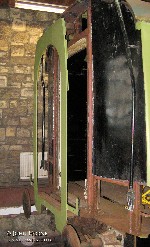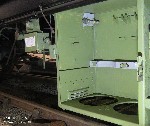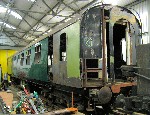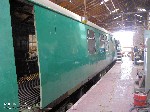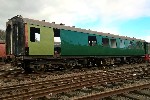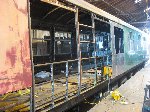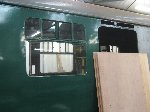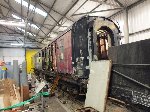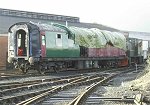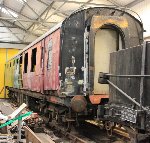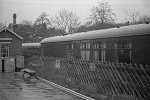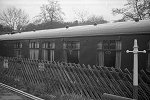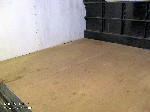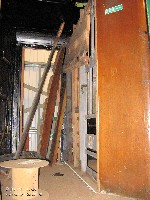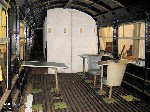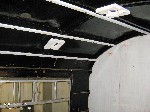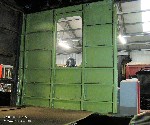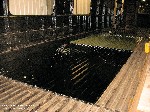79443 E&G Trailer Buffet First Lavatory Lavatory
Home Railway |
Location History |
North Yorkshire Moors RailwayApr 73-May 94 |
|
Current Location |
|
Bo'ness & Kinneil RailwayMay 94-Present |
|
Current Status |
Under Restoration |
|
|
Current Livery |
BR Green |
||
TRA Designation |
|||
Partner Vehicle(s) |
None |
|
|
Owner |
Scottish Railway Preservation Society |
|
|
Website |
|||
Record Last Updated |
16 November 2024 |
||
Preservation Modifications |
|||
Preservation Information 79443 was used as a static buffet at Goathland until its blue asbestos contamination resulted in its disposal in 1994. Luckily the Scottish Railway Preservation Society saved the vehicle (which was now the only surviving Edinburgh & Glasgow vehicle), stripped it of asbestos whilst still at the North Yorkshire Moors Railway and moved it to their base at the Bo'ness & Kinneil Railway. Understandably, the SRPS had the full scale rebuild of its Class 126 3-car set to undertake, so 79443 was put into long term store to await its turn for restoration once resources were available. In 2008, with the Class 126 3-car set completed, attention turned to 79443. Bodywork repairs were started, and it was decided to replace both the steel panels and framework as 79443 was in very poor condition. 2009 saw exploratory work done to the exterior of the vehicle, with parts removed for assessment. The restoration started in earnest the following year when the vehicle was moved undercover. In 2010, the No1 (compartment end) was rebuilt. All fixtures and fittings such as the gangway rubbing plate, springs, timber, pass-comm equipment, water filler pipes, footsteps and so on were removed. The buffer beam was stripped of all but the buckeye coupling: jumpers, sockets, steps, buckeye chain, etc. The bodyside doors, one each side, were taken off and refurbished. Some careful sanding was done on the end to reveal the vehicle's overhaul history and the various lettering applied through the years. The window frames were also removed down one side of the vehicle. New metal was then welded on the inside of the length of the bodyside replaced, along the bottom edge, to form the new box section. New curved L-section pieces for the join between the end and roof were painstakingly made and fitted to No. 1 end. All new metal, plus adjacent panelling and framework, was then primed and covered with bitumen paint. Both gangway doors were fully restored during the summer. The end of the roof was completed early in 2011. A new door pillar was fabricated and welded in at the corner of No. 1 end and corridor side. Metalwork above that door was repaired and new panels fitted. Rotten panels and framework were cut out from No. 1 end to approximately the centre of the vehicle on the unrestored side. All but the top few inches of the panels were replaced. Most of the new framework has been In 2012, the gangway rubbing plate was refitted.Bodywork restoration took another leap forward, with almost all of the framework repaired on the corridor side with two-thirds of the bodyside replaced with new panelling. On the compartment side two-thirds of the framework repairs were compleed and just over half of the bodyside replaced. The underframe was descaled, primed and painted on approximately half the length of the vehicle. The first sections of new flooring were cut to size and welded in place, again starting from No. 1 end. In 2013, the four windows fitted on the corridor side were completed with sliding lights and alloy trim. The four window openings on the other side were trimmed to exact size. Main and quarter lights were then fitted to the three compartment windows. All sliding lights not on the vehicle were re-painted ready for use. Welding repairs to the corridor side were almost completed, and primer applied to that side. New timber was fitted around one of the door openings on that side so that the first door could be installed. The recently fitted windows on the other side have been painted. Work on the new floor continued, with half the vehicle completed. Work to rebuild the partitions between the toilet, compartments and buffet area and was started. The first three partitions were cut to size and shape and successfully trial-fitted. All components needed to rebuild the compartments were gathered together to assess what was missing. Partitions and panelling were cleaned of many years of dirt, and sanding of interior woodwork for the compartments was underway. Painting of the interior of the roof was also completed. 2014 saw work continue to progress. Another partition was refurbished making four in total, and the welding completed on the corridor side. This side was then repainted inside and out into green undercoat. Coach letter holders were fitted to both sides of the No1 end. Sanding and repairing of corridor doors and interior woodwork continued. 2015-2017 saw several stints completing more and more of the bodyside fabrication which would be essential for providing the solid base required to build up the rest of the vehicle. Included in this was replacement of the steel flooring, upon which the wooden floors sit. At the same time, more components for the interiors were repaired and other minor jobs undertaken on the underframe. In 2018 descaling of the underframe and solebar was undertaken with lots of cleaning and painting! Interior work included refitting more of the supporting timberwork to the passenger compartments. A summer work week in the goods shed (where welding and hot work is allowed) saw more fabrication work undertaken to some of the final sectiopns of corroded bodywork to be attended to. Further coats of bodyside paint were also applied during this period. In 2019 work concentrated on the underframe again with propane tank boxes fully restored along which much heater ducting and other services "below deck". Inside the vehicle, preparations for the buffet area seating were being made and more door woodwork returned to place. The 2020 winter work week saw the veneered toilet exterior walls fitted into place along with plywood flooring for it to sit on. This walling was common to mark 1 coaches and a salvaged example from a scrapped Corridor First was available to replace 79443's original which was lost in the asbestos stripping process. Progress was also made on sanding reclaimed compartment wall panelling (also salvaged, this time from scrapped Class 126 vehicles 59098 & 59099) destined for 79443's passenger compartments. The next three years was spent further assembling the compartment walls with a focus on supporting timber work in the ceiling and walls. The restoration of 79443 continues steadily. |
|||
Future Plans |
|||
Interior

